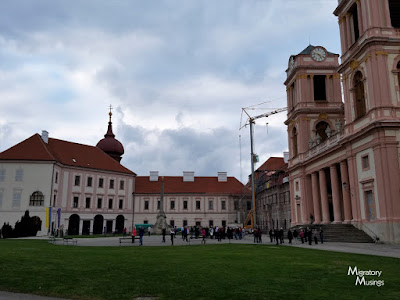Romantic Danube: Flying United from Chicago to Brussels
Romantic Danube: Brussels and continuing to Prague
Romantic Danube: Marriott Courtyard Prague
Romantic Danube: Exploring Prague
Romantic Danube: Boscolo, Autograph Collection
Romantic Danube: Prague to Erlangen
Romantic Danube: Viking Longships
Romantic Danube: Nuremberg, Germany
Romantic Danube: Weltenberg Abbey and the Danube Narrows
Romantic Danube: Regensburg, Germany
Romantic Danube: Passau, Germany
Romantic Danube: Wachau Valley and Göttweig Abbey
If you've ever taken an ocean (or large sea) cruise chances are that it included at least one "day at sea" as the distance between ports was too far to reach in one day. River cruises typically don't have a day without a port of call but having at least a morning or afternoon just spent cruising can be a welcome respite, especially if it's in the middle of a busy week.
While we didn't get to relax on our ship, after breakfast on Wednesday morning we packed up all our belongings and boarded motorcoaches. The expert Viking staff would take care of transferring our luggage to our new longship, the Bestla.
Once again we had to ride about two hours to get to our next destination, which in this case was a sight-seeing boat on which we'd tour the scenic Austrian Wachau Valley, which is a UNESCO World Heritage Site. While we stood on deck for a little while, before long it was time for lunch and we enjoyed watching the scenery pass by as we ate. Once we were refreshed we could better enjoy the sights of the Wachau Valley.
 |
| A local church with vineyards in the background |
When several of us had cruised the Middle Rhine a couple of years ago we saw dozens of castle ruins. We saw a few here though not nearly as many as on the Rhine.
 |
| Castle ruins |
 |
| Scenic small towns |
 |
| The remains of Dürnstein Castle |
 |
| The Blue Church and the Castle Ruins |
Göttweig Abbey is up on top of a hill and there's been a church in this location since 1072. The monastery was founded just 11 years later. The abbey was known as a seat of learning by the early 12th century. It seemed everything was going well but somehow by the mid-16th century there was no abbot and no monks. Shortly after a new abbot was named, fire destroyed the abbey in 1580. This new abbot had it rebuilt entirely by 1604.
 |
| A tower on one corner of the abbey |
 |
| Inside the gates of Göttweig Abbey |
 |
| The Bishop's Entrance and what I assume used to be the stables |
Considered a masterpiece of Baroque architecture, The Apotheosis of Charles VI features the Holy Roman Emperor, Charles VI, as Apollo who is surrounded by various people and angels. This is the same Charles whose influence was so apparent in Prague.
 |
| The magnificent ceiling fresco |
 |
| Beautiful sculptures below the ceiling fresco |
 |
| The abbey church |
 |
| The high altar |
 |
| The organ over the front door |
 |
| Altar in a smaller room below the pulpit |
Once again we got back on the buses but this time we were taken to our new home for the rest of the trip, the Bestla. The layouts of the longships are identical and the staff had taken our bags directly to our cabins where we found our keys waiting for us. Since we knew exactly where we wanted to store our belongings, unpacking was a snap. Except for the cruise director, Ulrike, and the concierge, Poulina, the crews stayed on their respective ships. But these two ladies had to pack up everything from their cabin and transport it back to the Bestla (which was their original ship). Of course their counterparts who "belonged" to the Njord had to do the same thing. While I was sorry they had to go through that, it certainly made it easier for us as we were quite familiar with this ladies by this point in the trip.
Only two ports of call remain on our cruise!



No comments:
Post a Comment